Dispatch review
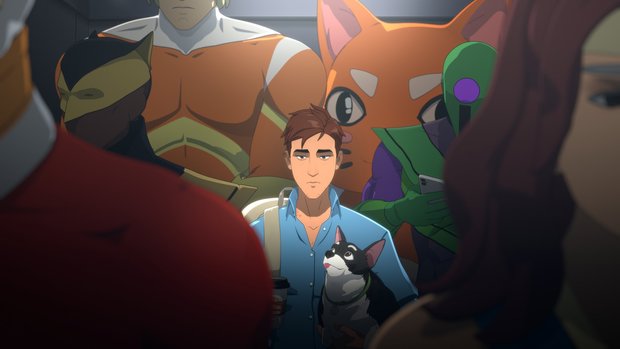
- 0 Comments
Telltale-styled superhero adventure is light on gameplay but a narrative knockout with a whole lot of laughs and heart
When thinking about what makes a comic book hero, chances are you’re picturing costumed characters with special abilities beating up bad guys, not plain-clothed civilians sitting at a desk. These are tales of “super” people, after all, and not being powered up doesn’t typically make for very exciting storytelling. AdHoc Studio apparently missed that memo, and with the full release of their eight-part debut adventure Dispatch, they have created a fantastic epic about an ordinary guy who learns to see the best in people and bring them together as a team – even if that team is filled with dastardly ex-villains. While the gameplay is limited (as you’d expect from a group founded by former members of Telltale), this is a narrative-focused, character-driven adventure that I can still confidently call a phenomenal achievement that packs a surprisingly emotional punch.
Dispatch is about superheroes, but it is not your average superhero story. You play as Robert Robertson, a regular guy without special powers living in an alternate universe modern-day Los Angeles, where superheroes and supervillains are an everyday part of life. Robert is the third generation of men in his family to don a state-of-the-art iron suit to become Mecha Man. His dad was killed by an old ally-turned-villain now known as Shroud, who has formed a criminal group of augmented baddies. Called The Red Ring, their syndicate’s notoriety is matched only by their brutality. Robert has been tracking Shroud for years to bring him to justice, but when he finally locates the hideout, he discovers too late that it was a trap to take him and his mech suit down for good. Robert barely escapes with his life, but his suit is completely destroyed (and its miraculous power supply, the Astral Pulse, lost in the blast). Since Robert’s broke, he can’t afford the materials needed to rebuild the suit, so in a public press conference he announces that Mecha Man is no more.
Or, he would be if Robert didn’t receive a surprise visit from local superhero celebrity Blonde Blazer. She was given an assignment by her employers at the Superhero Dispatch Network (SDN) to recruit the newly suitless Mecha Man as a dispatcher – not leading the way but staying behind and sending other heroes out to help those in need, in a town where all too many things go wrong for the good guys to attend to all at once. Blonde Blazer makes Robert an offer he can’t refuse: if he works for SDN, they will give him access to their resources to rebuild the Mecha Man suit.
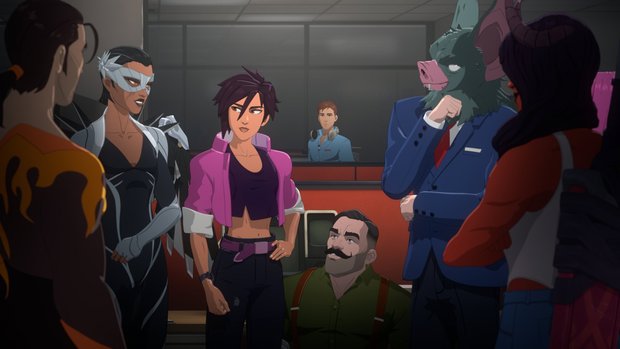
Of course Robert accepts the job, but after an initial training session with genuine superheroes, he soon discovers that his team actually consists of (barely) reformed supervillains from the Phoenix Program, a special rehabilitation opportunity that allows captured criminals the option to work for SDN on the Z-Team under parole. (As in, you want to exhaust literally every alternative option before resorting to picking them.) Unsurprisingly, having a bunch of baddies as your group of dispatch-ees leads to some… problems early on. But Robert Robertson is up for the challenge, and with time he learns that first impressions aren’t everything. Given enough motivational speeches, successful missions, and a whole lot of alcohol, the Z-Team slowly transforms into a weird motley crew of misfits that proves even villains can be heroic (sometimes).
Gameplay in Dispatch is split between three different elements: typical Telltale-like story-rich sequences where you make choices in dialogue, a fun but simple computer hacking minigame to unlock barriers and open new pathways for your team while they’re in the field, and the dispatching sections where you send out your charges to perform tasks for callers requesting SDN aid. Anyone who has played one of Telltale’s narrative game series will feel right at home as the story plays out (except here there’s an option to turn off quick time events, which I very much appreciated), but the hacking minigame and dispatching sections are entirely their own thing. Their inclusion comes at the expense of exploration, however, as there’s no opportunity to move Robert around in between sending heroes on missions and interacting personally with his team.
It would have been fun to personally walk around areas like the SDN building and the neon-soaked streets to bathe in the phenomenal atmosphere at some point. Instead, when called upon you’ll guide your team through this world by hacking your way past obstacles they encounter. Sometimes it’s as simple as unlocking electronic doors, but Dispatch’s Los Angeles is filled with various technologies all connected online, and causing a massive crane to spin around, for example, is more exciting and helps make your hacking feel more grounded in the goings-on of your hero team.
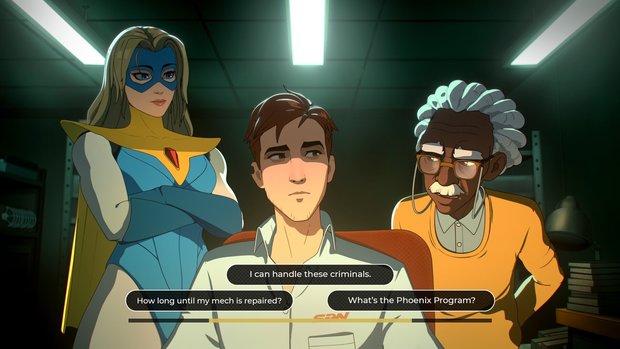
Hacking starts out simplistic, but slowly evolves as you progress through the eight episodes. Via keyboard/mouse or gamepad, you control a small sphere being moved around a grid maze of blue lines, where every few steps there’s some sort of interactive node that pops up – a key, a switcher that moves the orientation of blue lines, etc. Most of them require you to press some kind of input button or key that will unlock their corresponding effect. Later episodes add additional hazards like anti-virus spheres that will chase you down, or nodes that require an electrical charge to be carried from another node location, but the end goal remains the same. When you make your way to the end of the course, your sphere will crash down and unlock your target. By default, some hacking sequences limit the number of failures available, but there is an option to turn on unlimited attempts if you’re having trouble.
Dispatching heroes is a much more involved experience, in which a wire frame map of the city pops up. A pool of heroes is shown as character icons along the bottom of the screen, and each has a set of stats that differ depending on what their strengths and weaknesses are (power, charisma, speed, endurance, and so on). As you attempt to juggle responses, various calls to SDN will come up in real time from individuals asking for aid. These range anywhere from taking down a supervillain crime gang to helping an old lady get to her doctor’s appointment on time.
Once you’ve chosen a distress call to tackle (highlighted on your map), you’ll see the skills best suited for the situation, along with one or more slots to assign heroes to confront the threat. Calls with lower difficulty have fewer slots available, so you can’t send three people to go pick up someone’s coffee (not all calls received are exactly hero-worthy) when one can easily do so. You can choose to ignore any calls that pop up if you want, but missed objectives will detract from your performance review at the end of the shift. Once a hero has been assigned, they will be unavailable until their current objective is finished (shown by a meter next to the location on your map).
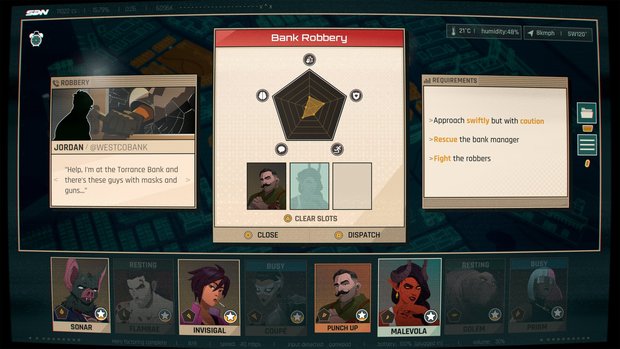
Sometimes additional issues will come up that require more direct assistance from you as a dispatcher. Typically you’ll be provided with three text options to instruct your hero how to deal with the situation, such as when one is tasked with giving a speech at a museum exhibition about being from an alien planet when they are not, in fact, from an alien planet. Other times you’re given a context-sensitive choice that is only available when the associated hero is assigned to that particular mission. When you pick that option, you are guaranteed to succeed. For example, Malevola, as a half-demon, is well versed in outer realm eldritch abominations and has some rather unique ways of dealing with a cult trying to summon a particular old god that only she can utilize.
Calls are pre-determined for each episode, but there’s enough variety of requests that the tasks you’re dealing with never feel like they’re treading the same ground. Early in the game you’ll have to help get a cat out of a tree, which is as harmless as it sounds, so when a later call came in requesting a sitter for another person’s cat, imagine my surprise to find out it’s actually a tiger, with the team needing advice on how best to deal with the situation before it breaks out of the house and onto the streets.
Some dispatching sections have overarching mini-stories, such as one involving various calls from a nefarious knock-off of Batman’s Riddler, who is planting bombs across the city along with brain teasers at each location, giving three options to choose from regarding where to look for the bomb when you get there. (I was not very successful in solving these myself, and I had one or two unhappy customers whose places of business were blown up by my poor choices.) But even with such potentially explosive setbacks, the calls continue and the story moves forward regardless of the outcome. Overall, the dispatching assignment never feels like a disparate part of the experience, and AdHoc masterfully weaves the field work into the story.
After completing a task, your heroes will return to SDN headquarters to rest and recharge. While they relax, a meter is shown next to their icon at the bottom of the dispatch screen, indicating when they will be ready for another mission. Their last completed assignment will be checked off on your map, and clicking on it shows you the performance review of the hero or heroes you assigned. A graph displays the skills needed to combat the task, fully or partly filled in with the skillset of whomever you sent out to handle it. A ball will bounce around the graph at random, and if it lands where the hero graph overlaps the task graph, your hero(es) will have successfully completed the job. If the ball lands outside area, the attempt failed instead.
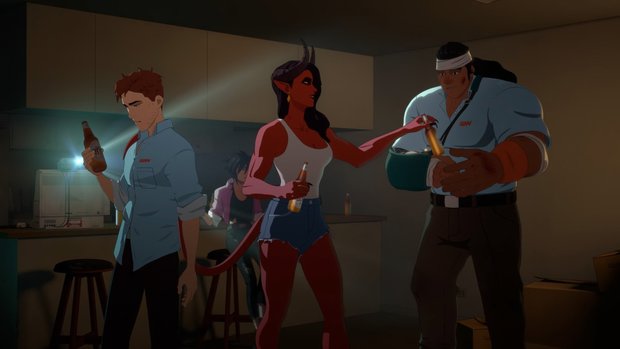
When a hero completes enough missions successfully, they will get additional skill points that can be allocated to their various stats and increase their effectiveness. Heroes also learn unique abilities as you uncover more of their particular skill sets. One of my personal favorites was the light-bending pop star Prism learning to make reflective copies of other heroes accompanying her.
During some particularly dangerous distress calls, failure can result in your hero getting wounded or even sidelined from the rest of the mission entirely, requiring time to recover back at SDN headquarters. However, sometimes you have too many calls to send only your fully healthy heroes out. If a hero is already wounded, then hurt again on another dangerous mission, they will need medical attention and be unavailable for the rest of the shift. You must weigh the risk of whether or not it’s worth it to send a teammate out who might be knocked out of commission for an extended period of time. There’s no risk of your hero actually dying, thankfully, and downed heroes are brought back as the story progresses. (Any injuries that crop up during dispatches don’t carry into the main story sections either.)
If that all sounds straightforward enough, each dispatching shift has any number of curveballs that will be thrown your way. Your first with the Z-Team has them bickering and arguing amongst themselves while out on the job, and members of the team like the hot-headed Flambae will run off to do their own thing, causing further issues that the rest of the group has to deal with. A later dispatch takes place during a massive city-wide power outage, and you’ll have to slowly bring the power back online in order to restore coverage to the different areas of LA, allowing assignments to pop back up on the screen for your team to tackle.
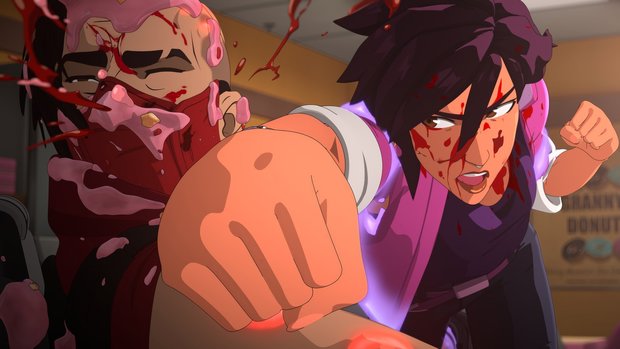
At the end of each shift, you can receive different rewards for your good work and choosing the right heroes for the right job, including helpful items that can put heroes back in action when they are injured or resting. In keeping with Telltale precedent, though, there’s no way to truly fail – the story continues moving forward even if you botch every distress call.
The lack of any real consequence is a double-edged sword. I was glad there was no need to redo difficult dispatches or hacks to keep things moving, but I was surprised to find just how firmly attached the training wheels are for the entire game. The quick time events are primarily used during great fight sequences between the heroes and villains of Dispatch going toe to toe. However, not only can you turn them off completely, I found that if you leave them on but fail them, the game progresses as if you had successfully pulled off the needed input anyway. This was a disappointing realization, as typically in games with QTEs there’s some kind of slap on the wrist if you fail. I wasn’t surprised when it happened in the opening fight sequence to help ease players in, but testing it out on a later fight scene confirmed that it is present throughout the game.
The lack of repercussions extends to certain hacking sequences with a time limit imposed to reach the target before Robert runs out of spheres or the timer reaches zero. In one case, I got zapped by an antivirus on my last remaining attempt to open a safe remotely, but rather than having to restart, I was surprised to see the game continue on with a minor note from the characters that the safe was unlocked anyway somehow. It made me feel like there was no real point to the hacking when the outcome of the situation was going to be the same regardless. There are non-hacking situations with similar time limits imposed that I won’t spoil here, but there too, the plot moves forward regardless of my direct actions.
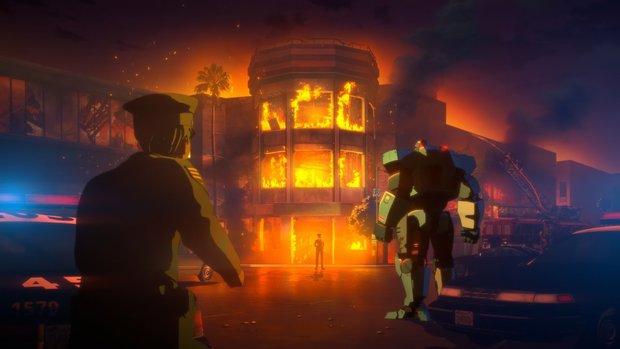
Thankfully, while I was let down by the lack of player agency in some aspects of the game, the choose-your-own-adventure-style gameplay is where Dispatch truly shines. Every character is wonderfully realized with believable personalities and constantly hilarious dialogue brought to life by terrific voice performances. You get a sense of each personality right off the bat – the big muscle guy Royd has a towering presence, but within moments of witnessing his hulking frame you are given the option for a fist bump. (At first I assumed Royd was a sweet idiot, but found out very quickly that he is much brainier than he first lets on.) Robert’s long-time family friend Chase looks like a crotchety old man and swears like a sailor, but you’d be crotchety too after learning what Chase has gone through before you catch up with him at SDN.
There are lots of small choices to make across the eight episodes, and a few major, clearly telegraphed decisions that change the way certain aspects play out (without impacting the overall course of the story). A player could easily experience an entire scenario with one particular character that another player never sees before they roll credits. In some scenarios, a character will appear only if certain choices were made earlier on, while others are more cosmetic, simply swapping characters with mild differences like a few lines of dialogue being new here and there. That isn’t to say that the dialogue changes are meaningless, though. The quality of the writing is incredibly strong throughout every version you can experience. There’s an auto-save system to record your progress as you go along, but you can go back and restart any scene from an episode you’ve completed to override your current story if you wish. This is great for checking out different outcomes without having to replay the entire eight-episode series from the beginning.
Even outside of major plot points, the small moments in between are given a ton of love as well. Something as mundane as choosing what snack to get from the vending machine has a full suite of associated animations and dialogue. And on the topic of animation, this game is absolutely stunning visually. Every scene feels like a cel-shaded interactive cartoon TV series, with fully rendered 3D environments populated by gorgeously detailed characters. Everyone you meet is expressively animated, with a deliberately lower frame rate evocative of the Spider-Verse movies or even comic art in motion. This is especially apparent in the incredible fight scenes that crop up, with every punch and swipe of a sword being brutally felt (even if it’s largely as a passive observer). Even Robert’s adorably rotund dog Beef is given a ton of attention in the way he moves, waddling around and spoiled with a little doggie bed in Robert’s cubicle.
Completing the outstanding presentation, I have to give a huge shout-out to the incredible soundtrack – both original pieces and licensed music. There’s an 80s pop vibe throughout the game, with a synth-heavy score that majestically soars when some suitably heroic action is playing out. One of my personal favorite scenes has Prism performing the song “Hoes Depressed” live in character, which in reality is sung by her voice actress Thot Squad. My favorite track is “Feel the Way I Do” by Primer, a relatively recent song that adheres to my specific tastes for 80s synth-styled music.
Each episode takes roughly 45 minutes, and as the story progressed I felt myself getting more and more attached to this crew of misfits in the Z-Team and their reasons for being there. The horned, red-skinned Malevola looks intimidating at first, but after getting late night tacos with the rest of the crew, it’s hard to see her as a big scary demon anymore. Same with Golem, a giant, hulking clay construct who eventually reveals that he has to take weed gummies to get a good night’s sleep. Flambae performs some hilarious karaoke at a bar, throwing tons of playful jabs at Robert in a “creative” new take on an established song. Even in a world of monsters and freaks, AdHoc deftly breathes humanity into its LA super-denizens. This is sometimes conveyed through strong language, bloody violence, and nudity, but if you want to tone any of these down there are user-friendly toggles in the main menu for a less risqué experience.
The last episode’s climactic finale ramps up the stakes and lends itself to some of the game’s best moments. The dispatching shifts here utilize the gameplay mechanics in a particularly cool way, with a major threat actually feeling like a big deal. There are multiple main endings possible, based on various decisions you’ve made throughout, especially in some select key moments. The ultimate outcome is largely the same in all endings, but some significant changes can occur depending on how your story has played out to that point. I was happy with how things wrapped up in my playthrough, and I’m looking forward to seeing a few other outcomes when I inevitably boot the game back up sometime in the future.
Final Verdict
It isn’t unheard of for superhero stories to be adult in nature, but while many like Watchmen or Invincible tend to have a darker tone, Dispatch is above all just a ton of fun. There are some emotional scenes and life is not always rosy in this alternate version of Los Angeles, but the overwhelming majority of the time I was having a blast laughing along with these misfits and their day-to-day experiences in a world where superpowers are the norm. I would have liked the freedom to see more of the city outside of the dispatcher’s chair, and it’s too bad so little importance is given to actions for which failure should have consequences, but it’s a testament to the quality of every other aspect of the production that these ended up being relatively minor setbacks when compared to the massive enjoyment I had with my time with the Z-Team. I guess you could say my time with Dispatch was pretty… super.
Hot take
More of a cinematic, highly polished visual novel than a full-fledged adventure game or even a strategic superhero simulator, Dispatch makes being the proverbial “guy in the chair” a delightful experience well worth hopping into.
Pros
- Memorable characters with hilarious and at-times emotional writing backed by stellar voice performances
- Large variety of outcomes to individual storylines
- Rich narrative focused on character relationships
- Gorgeous cel-shaded animation
- Accessible interface that never feels overwhelming
Cons
- Lack of any free exploration
- Simple gameplay that’s a bit too easy
- Quick time events and timed objectives are borderline pointless
Sam played Dispatch on PC using a review code provided by the game's publisher.


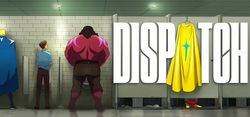
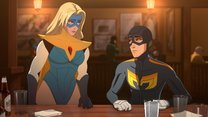

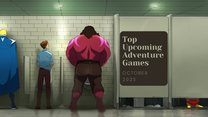

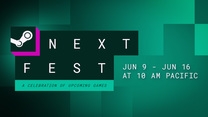



0 Comments
Want to join the discussion? Leave a comment as guest, sign in or register.
Leave a comment